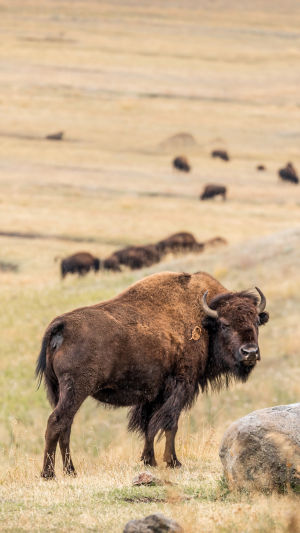The American bison, which can weigh up to 1 ton, is the largest mammal in North America, and lions dare not provoke it easily. No one would have thought that this prairie overlord was "tossed" to the brink of extinction by the United States. Why did the United States do this? What is the fate of the American bison now?
When human beings were still in primitive society, American bison already lived on the grasslands of North America. They are large, aggressive by nature, and run surprisingly fast. Most carnivores are afraid to provoke them, which also makes them once very large, as many as tens of millions.
The American bison is also a relatively rare species in the biological world. The biggest weapon of this kind of stealth and aggressiveness is the "double horns" on its head. There are a pair of sharp double horns that curve upwards on its head.
Even in the face of the most aggressive predators, it does not flinch. And their "double horns" also have obvious concealment, which is hidden in their brown hair. Therefore, if other creatures do not pay attention in battle, it is easy to die tragically under the horns of the bison.
The American bison mainly inhabits the boreal forests of North America and is limited to North America. It is a species with a relatively narrow distribution range. On the whole, its body is thicker than that of the European bison.
However, the body and limbs are not as long as those of the European bison, and their sense of smell is good and vision is poor, which are its basic characteristics.
In the American prairie, there are still some Indians who mainly hunt American bison for food. The fur of bison can be made into clothes, and the horns of bison can also be used as decorations.
During this period, the Indians were still uncivilized Native Americans and did not use guns and powder to hunt bison, so the bison population was not threatened.
It wasn't until the early 19th century that Europeans landed in the Americas and brought the fur trade. The hunting of guns and gunpowder is undoubtedly a disaster. The American bison were slaughtered to less than 100, almost extinct, and all kinds of cowhide and horns were brought back to Europe to sell to merchants.
Until 1905, President Roosevelt of the United States listed the American bison as a protected animal, and the bison population has also been restored and has been pulled back from the brink of extinction. In 2016, the American bison became the national animal of the United States.
Chinese giant pandas, Australian kangaroos, and American bison are all national animals in various countries, but they are treated differently. The Chinese giant panda once belonged to a species that was about to become extinct. China has made unremitting efforts to downgrade the giant panda from "endangered" to "vulnerable".
Pandas have also established diplomatic relations with many countries, and they need to make an appointment to receive the national treasure panda so that they can enjoy the best treatment in the country.
Although the Australian kangaroo is Australia's nominal national treasure, it was brought to the table because there are too many kangaroos. As national treasures, pandas and kangaroos are treated very differently.
Look at the American bison, which was almost wiped out by the United States first, and then was protected as a national beast, bearing the blood and tears history of the American prairie.
So as the national animal of the United States, how many American bison are there? If the number is too big, will they be brought to the table again like the Australian kangaroo?
According to statistics from the United States in 2017, there are currently about 500,000 bison in the United States (mostly in captivity), of which 5,000 are in Yellowstone Park, which is the largest wild population in the United States.
What is even more ridiculous is that, due to the lack of control of wolves and bears, Yellowstone Park regularly kills a group of American bison every year according to the situation. From this point of view, the days of the American national beast have also lived with anxiety.





